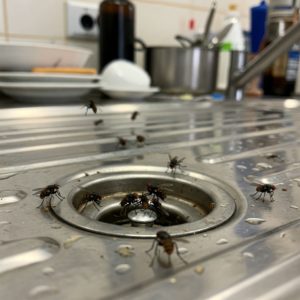Unmasking the Unseen: Understanding and Eliminating Drain Flies
Those tiny, fuzzy insects fluttering around your drains might seem like a mere nuisance, but they’re a telltale sign of a hidden ecosystem thriving within your plumbing. Drain flies, also known as sewer flies, moth flies, or sink flies, are more than just a passing annoyance. These ¼-inch insects, with their characteristic pale gray to black coloration, moth-like wings, and rounded, fuzzy bodies, are indicators of stagnant water and organic buildup within your pipes.
Where Do These Pests Originate?
Drain flies are drawn to environments with stagnant water, where even minimal bacteria and sewage accumulate. This explains their prevalence in areas like:
- Kitchen and Bathroom Drains: Sinks, showers, and bathtubs provide the perfect breeding ground.
- Basement Sinks: Especially those infrequently used, allowing for stagnant water buildup.
- Sewers and Septic Tanks: Naturally, these areas are rich in the organic matter drain flies thrive on.
- Contaminated Soil: Soil saturated with sewage provides an ideal habitat.
The common thread is stagnant, slow-moving water, which allows a film of organic matter to form on pipe interiors, attracting drain flies to lay their eggs. This extends to:
- Wet Mops and Buckets: Left unattended, these can become breeding sites.
- Compost Piles: The decaying organic matter is a food source.
- Storm Drains: Standing water provides a suitable environment.
- Wet Areas: Around garbage, birdbaths, or barns, where moisture and organic matter combine.
With a rapid lifecycle, drain flies can lay up to 300 eggs within 48 hours, making swift action crucial to prevent a full-blown infestation.
Addressing the Infestation: Natural Solutions
While drain flies aren’t known to transmit diseases, their presence signifies unsanitary conditions. Here are some natural methods to eradicate them:
- Boiling Water: A simple and effective first step. Pour boiling water down drains once or twice daily for a week to eliminate flies and larvae.
- Baking Soda, Salt, and Vinegar: Create a powerful cleaning solution by mixing these ingredients and pouring it down the drain overnight. The baking soda’s expansion, combined with vinegar’s cleaning properties, reaches deep into pipes. Flush with boiling water in the morning.
- Soap, Water, Sugar, and Vinegar Trap: Create a homemade trap by mixing dish soap, water, sugar, and apple cider vinegar in a bowl. The sweet solution attracts flies, while the soap traps them. Repeat as needed to break the breeding cycle.
- Hydro Jetting: For a thorough and environmentally friendly solution, consider hydro jetting. This professional service uses high-pressure water to clean drains and sewers, eliminating drain flies, larvae, and the organic buildup they thrive on.
Preventing Future Infestations
Prevention is key to avoiding recurring drain fly problems:
- Maintain a Healthy Septic System: Regular maintenance prevents organic buildup.
- Early Detection: Be vigilant for signs of infestation, even a few flies.
- Eliminate Standing Water: Prevent stagnant water buildup in and around your property.
- Regular Cleaning: Clean drains regularly to prevent organic matter accumulation.
- Outdoor Maintenance: Clear stagnant water from birdbaths, gutters, and other outdoor areas.
- Air Conditioner Maintenance: Keep the area around air conditioners dry.
If DIY methods prove ineffective, consult a professional plumbing or pest control service. They can assess the situation and implement targeted solutions to eliminate the infestation and prevent its return.
By understanding drain flies and implementing these preventative and remedial measures, you can maintain a clean and healthy plumbing system, free from these unwanted pests.
Investing in Peace of Mind
A thorough plumbing inspection is an investment in your peace of mind. By using the checklist and understanding the potential issues, you can make an informed decision and avoid costly surprises. Consider hiring a professional plumbing inspection service, like Option One Plumbing, to provide a comprehensive assessment of the home’s plumbing system.

